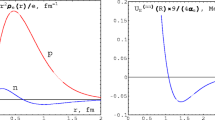Summary
By considering an effective charge on the neutron inside the nucleus, we study the effect of the neutron charge structure (G n E ) on the charge form factors ofs-shell nuclei. With a newly established form (particularly, the modified Clementel-Villi form) forG /n E , the calculated results for4He and3He are found in fairly good agreement with recent experiments. It is observed that the account of this new ingredient may offer an alternative to the corrections arising from various short-distance effects.
Riassunto
Considerando una carica efficace sul neutrone all’interno del nucleo, si studia l’effetto della struttura di carica del neutrone (G /n E ) sui fattori di forma della carica dei nuclei a stratos. Con una forma stabilita di recente (in particolare la forma modificata di Clementel-Villi) perG /n E si è trovato che i risultati calcolati per4He e3He sono in abbastanza buon accordo con gli esperimenti recenti. Si è osservato che la considerazione di questo nuovo elemento può fornire un’alternativa alle correzioni che derivano da vari effetti a breve distanza.
Реэюме
Рассматривая зффективный эаряд на нейтроне внутри ядра, мы исследуем влияние структуры эаряда нейтрона (G /n K ) на форм-факторы эаряда дляs-оболочечных ядер. Испольэуя недавно установленную форму дляG /n E (в частности, модифицированную форму Клементеля-Вилли), проводятся вычисления для 4Не и 3Не, которые довольно хорощо согласуются с недавними зкспериментами. Отмечается, что учет такого нового ингредиента может служить общяснением поправок, воэникаюших иэ раэличных короткодействуюших зффектов.
Similar content being viewed by others
References
R. G. Arnold, B. T. Chertok, S. Rock, W. P. Schütz, Z. M. Szalata, D. Day, J. S. McCarthy, F. Martin, B. A. Mecking, I. Sick andG. Thomas:Phys. Rev. Lett.,40, 1429 (1978).
M. Gari, H. Hyuga andJ. G. Zabolitzky:Nucl. Phys. A,271, 365 (1976);M. Radomski andD. O. Riska:Nucl. Phys. A,274, 428 (1976);W. M. Kloet andJ. A. Tjon:Phys. Lett. B,49, 419 (1974);61, 356 (1976). For a critical survey see the work cited in ref. (1).
Partly in the sense that none of the calculations has so far been able to reproduce (see ref. (1)) both the dip structure and the second maximum simultaneously. Further, though the inclusion of short-range correlations could lead to some satisfactory results for this purpose, however, not in terms of a unique set of parameters for several nuclei.
R. F. Frosch, J. S. McCarthy, R. E. Rand andM. R. Yearian:Phys. Rev.,160, 874 (1967).
J. S. McCarthy, I. Sick andR. R. Whitney:Phys. Rev. C,15, 1396 (1977);J. S. McCarthy, I. Sick, R. R. Whitney andM. R. Yearian:Phys. Rev. Lett.,25, 884 (1970).
B. T. Chertok:Phys. Rev. Lett.,41, 1155 (1978);S. J. Brodsky andB. T. Chertok:Phys. Rev. D,14, 3003 (1976). For a consideration of quark exchange ideas in more complex nuclei seeD. Robson:Nucl. Phys. A,308, 381 (1978).
R. Berard, F. R. Buskirk, E. B. Dally, J. N. Dyer, X. K. Maruyama, R. L. Topping andT. J. Traverso:Phys. Lett. B,47, 355 (1973);S. Galster, H. Klein, J. Moritz, K. H. Schmidt, D. Wegener andJ. Bleckwenn:Nucl. Phys. B,32, 221 (1971);W. Bartel, F. W. Busser, W. R. Dix, R. Felst, D. Harms, H. Krehbiel, P. E. Kuhlmann, J. McElroy, J. Meyer andG. Weber:Phys. Lett. B,39, 407 (1972).
Yu. I. Titov, N. F. Severin, N. G. Afanaser, R. V. Akhmerov, S. A. Byvalin, A. S. Omelaenko, E. V. Stepula andE. M. Smelov:Sov. J. Nucl. Phys.,13, 304 (1971).
A. Le Yaouanc, L. Oliver, O. Pené andJ. C. Raynal:Phys. Rev. D,18, 1733 (1978), and the references therein;M. Gupta andA. N. Mitra:Phys. Rev. D,18, 1585 (1978).
L. M. Sehgal:Phys. Lett. B,53, 106 (1974);D. Parashar andR. S. Kaushal:Phys. Rev. D,13, 2684 (1976);A. Niegawa andD. Kiang:Phys. Rev. D,15, 3488 (1977);R. S. Kaushal andD. Parashar:Nuovo Cimento A,39, 272 (1977);R. D. Carlitz, S. D. Ellis andR. Savit:Phys. Lett. B,68, 443 (1978).
R. S. Kaushal andD. S. Kulshreshtha:Ann. Phys. (N. Y.),108, 198 (1977).
R. S. Kaushal andD. Parashar:Nuovo Cimento A,32, 413 (1976);E. Clementel andC. Villi:Nuovo Cimento,4, 1207 (1956).
R. S. Kaushal:Nuovo Cimento A,51, 367 (1979).
More accurate experiments in the sense that either one should use fairly precise information on the deuteron structure as input in one type of experiments (ref. (6)) or else the smallq 2 (q 2 < 2 fm−2) behaviour ofG n E (q 2) should be extracted in other types of experiments (ref. (7)). Moreover, an overall accuracy in the second type of experiments is required.
L. J. Tassie andF. C. Barker:Phys. Rev.,111, 940 (1958).
Though the deviations from the dipole behaviour of the proton form factor are now known (14), however, they are found (15) to be significant only for very large values ofq 2 (q 2 ≥ 5 (GeV)2), which we do not consider in the present work.
K. M. Hanson, J. R. Dunning jr.,M. Goitein, T. Kirk, L. E. Price andR. Wilson:Phys. Rev. D,8, 753 (1973);F. Iachello, A. D. Jackson andA. Lande:Phys. Lett. B,43, 191 (1973).
P. N. Kirk, M. Breidenbach, J. I. Friedmann, G. C. Hartmann, H. W. Kendall, G. Buschhorn, D. H. Coward, H. DeStaebler, R. A. Early, J. Litt, A. Minten, L. W. Mo, W. K. H. Panofsky, R. E. Taylor, B. C. Barish, S. C. Loken, J. Mar andJ. Pine:Phys. Rev. D,8, 63 (1973).
G. R. Gerleson andR. Hofstadter:Phys. Rev.,112, 1282 (1958);Y. R. Waghmare andS. P. Pandya:Prog. Theor. Phys.,25, 822 (1965);R. S. Kaushal:Lett. Nuovo Cimento,2, 236 (1969).
H. Collard, R. Hofstadter, E. B. Hughes, A. Johansson, M. R. Yearian, R. B. Day andR. T. Wagner:Phys. Rev. Sect. B,138, 57 (1965).
I. Sick andJ. S. McCarthy:Nucl. Phys. A,150, 631 (1970).
J. E. Elias, J. I. Friedmann, G. C. Hartmann, H. W. Kendall, P. N. Kirk, M. R. Sogard, L. P. Van Speybroeck andJ. K. Pagter:Phys. Rev.,177, 2075 (1969).
Author information
Authors and Affiliations
Rights and permissions
About this article
Cite this article
Kaushal, R.S. Effect of the neutron charge on the charge structure of light nuclei. Nuov Cim A 58, 21–30 (1980). https://doi.org/10.1007/BF02730218
Received:
Published:
Issue Date:
DOI: https://doi.org/10.1007/BF02730218




